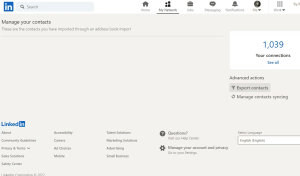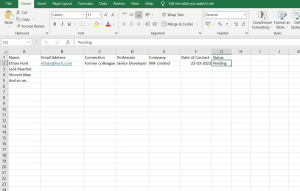Introduction: Navigating the Hidden Job Market In this digital age, where job boards and company websites flood with applicants, many career-defining opportunities remain hidden from the public eye. To proactively advance your career, it’s essential to tap into your network and seek job referrals. In this article, we’ll guide you through the art of asking
Introduction: Navigating the Hidden Job Market
In this digital age, where job boards and company websites flood with applicants, many career-defining opportunities remain hidden from the public eye. To proactively advance your career, it’s essential to tap into your network and seek job referrals. In this article, we’ll guide you through the art of asking for a job referral, providing you with actionable strategies and proven templates to pave your way to career success.
Finding the Right Allies: Building Your Referral Network
Before you embark on the journey of requesting job referrals, you must identify potential allies in your network. These allies can come from various backgrounds, including old friends, colleagues, previous employers, acquaintances, family members, or even former schoolmates. The key is to connect with individuals who can vouch for your professional abilities and character.

Image by https://www.makeuseof.com/
Leveraging Your Existing Connections
Start by harnessing your existing connections, both online and offline. Platforms like LinkedIn are invaluable for identifying individuals in your network who can assist you. Begin by exporting your LinkedIn contacts and compiling a list of potential allies using a simple tool like an Excel spreadsheet or Google Sheet.
Actionable Tip: Export your LinkedIn contacts by navigating to ‘My Network,’ clicking ‘Connections,’ selecting ‘Manage Contacts,’ and finally, opting to ‘Export Contacts.’

Image by https://www.makeuseof.com/
The Power of Weak Ties
Research indicates that weak ties, individuals with remote connections to you or even strangers, often possess more valuable connections than close friends or family. Therefore, if you have a specific company or industry in mind, seek out individuals affiliated with that organization, such as employees, clients, or vendors, and initiate connections with them.
However, exercise discretion when reaching out to employees within a company. Consider their position and tenure within the organization. Individuals who have served for at least two to three years, especially those involved in the hiring process or holding senior positions in your desired field, are more likely to provide meaningful referrals.
Example: If you aspire to secure an SEO specialist role, prioritize connecting with a seasoned marketing manager within your target company.

Image by https://www.makeuseof.com/
Expanding Your Professional Network
To expand your network further, join online communities and groups on platforms like LinkedIn, Twitter, Meetup, and Facebook, where professionals in your field congregate. Engaging in discussions, sharing insights, and connecting with industry peers and seniors can significantly enhance your chances of encountering the right individuals who can support your career goals.
Once you’ve identified potential allies, filter your list to focus on those who are not only capable of assisting you but also willing to do so. Initiate meaningful conversations by sending introductory messages, actively participating in comment sections, and making efforts to get noticed within your network.
Seeking Referrals: Strategies for Success
Now that you’ve curated a list of potential allies, it’s time to craft compelling requests for job referrals. Whether you choose to reach out via LinkedIn or email, the approach remains largely the same.
Crafting an Effective Referral Request
When composing your referral request, adhere to these crucial elements:
- Personalization: Address the recipient by their first name to create a personalized connection.
- Polite Greeting: Begin with a courteous greeting to set a positive tone.
- Introduction: If it’s your first interaction with the individual, introduce yourself briefly.
- Hook: Capture their interest with a hook, such as a shared interest or a noteworthy achievement in your field that makes you a compelling candidate.
- Offer a Choice: Make it easy for them to take action by presenting a choice. This encourages a comfortable response and minimizes potential delays. In case of refusal, you can swiftly move on to the next potential ally.
- Thank You and Sign-off: Conclude your message with gratitude for their consideration and a polite sign-off.
Proven Referral Request Template
Hello [First Name],
Hope life is treating you well.
I recently applied for a [copywriter position] at your company [XYZ Production]. I was wondering if you have any contacts with the hiring manager, [Her Name], and if you could refer me for this position. I’ve attached my resume to this email; you can see that I have [X years] of experience in this [field of work], and I’ve helped my clients achieve [some great results].
Let me know if you would be comfortable in doing so.
Thank you for your consideration.
Best,
[Your Name]
In addition to sending this email, if they agree to refer you to the intended person, further facilitate the process for them by providing a referral email template. This template streamlines their efforts in recommending you for the position.
Referral Email Template
Hello [Hiring Manager],
I’m writing to make a referral for [Full Name], who recently applied for a [Certain Position] at our firm. He was my [former colleague/fellow graduate] at [XYZ Company/XYZ College], and I’ve known him for [X years]/we worked together on a [certain] project. He’s a hard-working person, and I’m confident that he’ll be a good fit for this position.
Thank you!
Kind Regards,
[Your Name]
Transitioning Careers: Asking for Referrals with Confidence
Transitioning to a new career can be challenging, especially when recruiters seek candidates with specific domain experience. In such cases, reaching out to individuals involved in the recruitment process may not yield the desired results.
Instead, consider approaching seasoned professionals within your current field. They are more likely to recognize your expertise, understanding of the subject matter, and potential to excel in your chosen career path. To boost your confidence during this career transition, you may find it beneficial to explore resources like ‘The Self Esteem and Confidence’ podcast by Jonny Pardoe.
Informative Table: The Referral Request Checklist
| Element | Description |
|---|---|
| Personalization | Address the recipient by their first name. |
| Polite Greeting | Begin with a courteous greeting. |
| Introduction | Briefly introduce yourself if it’s your first interaction. |
| Hook | Capture their interest with a shared interest or achievement. |
| Offer a Choice | Present a choice to make it easy for them to respond. |
| Thank You and Sign-off | Conclude with gratitude and a polite sign-off. |
Comparative Table: Weak Ties vs. Strong Ties in Networking
| Aspect | Weak Ties | Strong Ties |
|---|---|---|
| Connection Type | Remotely connected or strangers | Friends, family, acquaintances |
| Networking Potential | Often have valuable connections | May have limited connections |
| Referral Influence | Can provide meaningful referrals | May have less influential referrals |
| Suitable for Referral Requests | Effective for referral requests | Effective, but not always the best choice |
Conclusion: Unlocking the Door to Your Dream Job
In the ever-evolving landscape of career opportunities, the ability to seek and secure job referrals stands as a strategic advantage. By investing time in research, network-building, and the courage to ask for referrals, you can significantly enhance your career prospects.
So, dare to take the unconventional route in your job search. Requesting a job referral might just be the pivotal move that propels your career to new heights. After all, while applying for the job you love remains the first step, asking for a job referral could be the next best one.

















Leave a Comment
Your email address will not be published. Required fields are marked with *